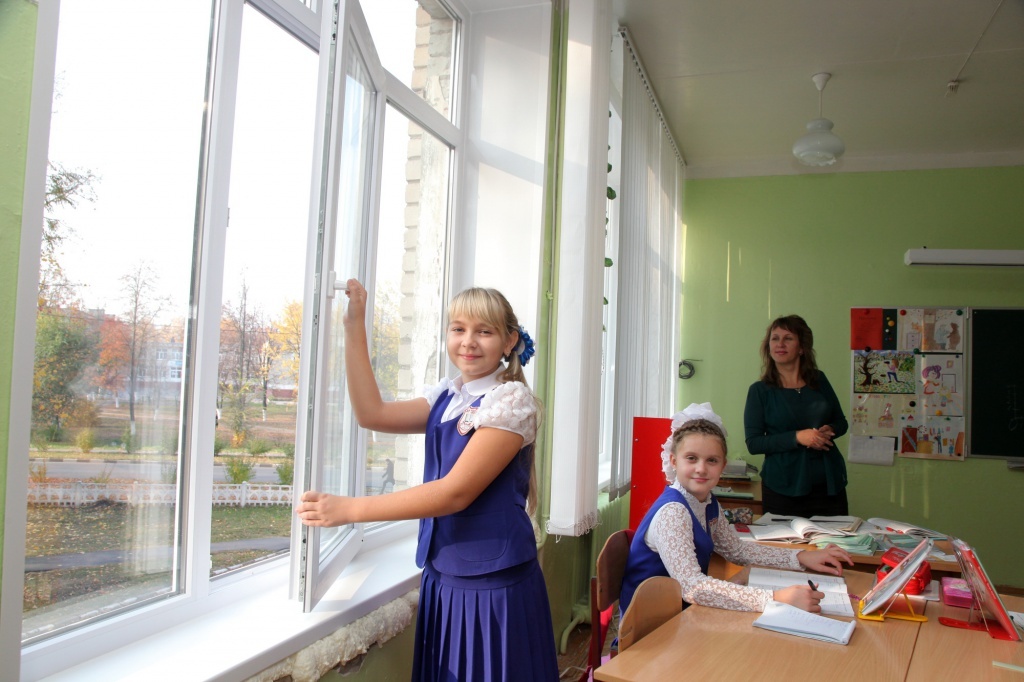If you are building a private house or a building for your company, then, probably, you have come across many standards and would like to forget about them already. But safety must come first, right? If you are thinking of starting construction or making artificial ventilation for a finished object, then take a look at the rates of the air exchange rate in the premises, which we have given in this article. Achieving a high-quality result is not so difficult if you pay due attention to everything. Do you agree?
From the article you will learn what air exchange is, how it is measured and what regulatory documents exist in this area. Also read about room-specific codes. Here you will also find examples of calculating the air exchange rate.
The content of the article:
- Air exchange rate and its value
-
Air exchange rates for premises
- Workshops and industrial premises
- Medical organizations and hospitals
- Offices and business centers
- Examples of calculating the frequency of air exchange
- Conclusions and useful video on the topic
Air exchange rate and its value
Air exchange - a quantitative value that reflects the operation of the ventilation system in an enclosed space.
Multiplicity - indicator of the replacement of air mass per unit of time, laid down in the design of buildings and ventilation systems. Before choosing a multiplicity indicator, you should familiarize yourself with the rules and understand the calculation methods.
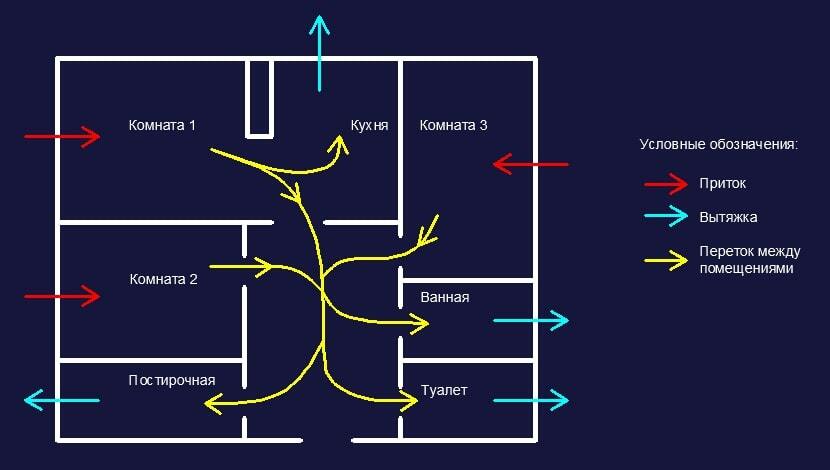
A simple scheme of air exchange in an apartment / house: for technical rooms, it is more important to remove air, for residential rooms - inflow, and the flow between rooms makes up for the missing amount of air
The air exchange rate is a sanitary indicator of the state of the air mass in the room. The safety and comfort of people depends on this parameter. Allowable values are regulated by the state - in building codes and regulations (SNiP), codes of practice (SP), sanitary rules and regulations (SanPiN) and GOSTs. The air exchange rate shows how many times during an hour the air was replaced with a new one.
The SNiPs on air substitution are based on the following nuances:
- purpose of the building / premises;
- air temperature and humidity;
- quality, intensity and capacity of natural ventilation;
- the number of residents, employees and other people permanently or temporarily in the premises;
- heat output of working devices;
- the number of household appliances.
There are 2 types of air exchange: natural and artificial. Natural way exchange consists in the movement of air masses due to the pressure difference. From points with high pressure - to places with less. Artificial air exchange involves the operation of fans, air conditioners and other electrical devices.
The formula for the air exchange rate looks like this:
N = Q air / V pom, where:
N or n - multiplicity (once per hour);
Q air - the required amount of fresh air per hour, m³ / h;
V pom - room volume, m³; if the room has a complex shape, the volume must be determined together with specialists.
Natural air replacement is limited to 3-4 times the indicator, so its movement sometimes has to be enhanced by mechanical ventilation.
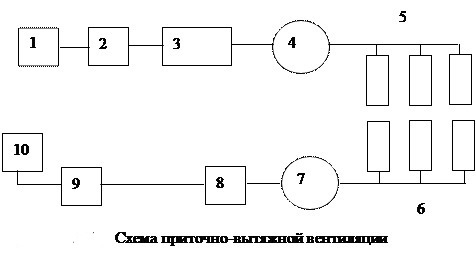
Supply and exhaust ventilation device (from 1 to 10): air intake, cleaning, air ducts, supply fan, device air supply, air removal device, exhaust fan, dust and gas separators, filters, air exhaust device
Ventilation systems work according to 2 schemes: they displace old air with new one or mix both of these masses.
For systems operating only for air removal, the basic formula for the ratio is as follows:
N = V y. v. / V pom, where:
V y. v. - volume of the removed air, m³ / h;
V pom - room volume, m³.
The volume to be removed should include heat emissions and volatile pollutants.
Separate multiplicity indicators are also calculated for supply and exhaust ventilation.
For example, for the supply system, it is defined as follows:
N pr = L pr / V pom, where:
L pr - capacity of the supply system, m³ / h;
V pom - room volume, m³.
The separate rate of expansion for exhaust ventilation is usually 1 or 2 units per hour more than the supply, but in some medical premises it is the other way around. The total fold is always measured according to the larger indicator.
The air exchange rate given in SNiPs and sanitary standards has 4 expressions:
- number of times per hour;
- cubic meters per hour - usually for standard sized rooms;
- cubic meters per hour per person;
- cubic meters per hour per square meter.
The last two indicators are the specific rates of air exchange for rooms where the presence of people plays an important role. Per person can be useful in manufacturing shops, shops and hospitals. At these sites, you can count the number of people and establish the average number of visitors.
One employee should be allocated 60 m³ / h, and for a temporary visitor - 20 m³ / h. Specific multiplicity acts as an informative indicator, provided that the dimensions of the room are close to standard.
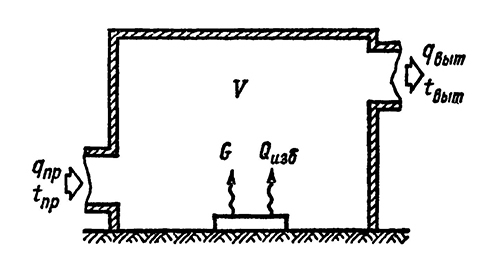
Air exchange in the room: Q g - excessive heat release, G - harmful gases or vapors, V - volume of the room, q pr - concentration harmful gases or vapors in the incoming air, q exhaust - the same, but in the outgoing air, t pr is the temperature of the incoming air, t exhaust - outgoing
There is also an air exchange rate determined by the formula:
E = T / (2 × Y) × 100%, where:
T is the volume of the room or incoming air;
Y is the air replacement time.
The coefficient can also be called the quality of air substitution. The indicator reaches 100% in ventilation that removes old air, and 50% in a ventilation system that mixes air masses.
The required ventilation performance is determined according to the air exchange rate.
The formula looks like this:
L = n × V pom, where:
L - productivity, m³ / h;
n - standard rate (once per hour);
V pom - room volume, m³.
The default ratio is 1-2 times for living rooms and 2-3 for office buildings. For bathrooms, the rate of air change starts from 3-5, and for kitchens - from 5-10.
Air exchange rates for premises
The insulated and sealed construction of houses leads to a decrease in the frequency of air replacement. As a result, harmful microorganisms multiply more intensively and general hygiene deteriorates.
In the norms and rules, they displayed critical values for air exchange, non-compliance with which will definitely lead to problems.
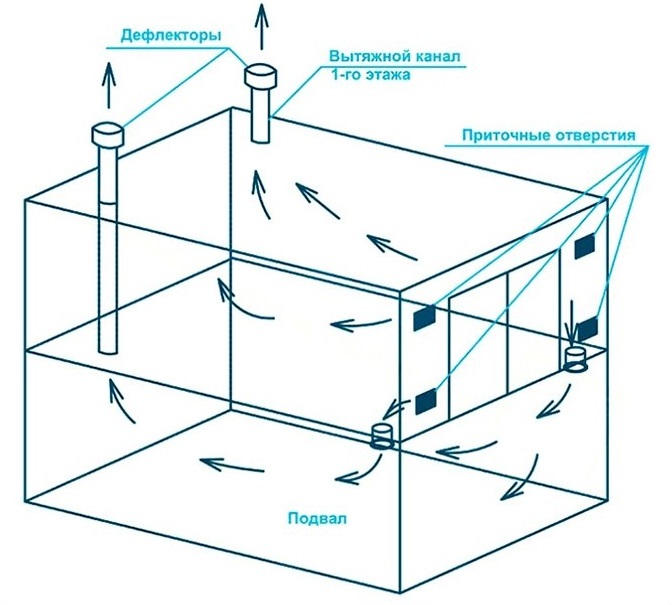
Air exchange using the example of a basement: to achieve the required multiplicity, you need several inlets and a deflector on the outlet pipe to enhance the outflow
For apartment buildings, various rooms and buildings have deduced the rates of the frequency of air exchange - in SP 54.13330.2016.
Individual rooms have the following requirements:
- kitchen with gas-using equipment - 80-100 m³ / h;
- kitchen with electric stove and without gas appliances - 60 m³ / h;
- bathroom / shower / toilet - 25 m³ / h;
- combined bathroom - 50 m³ / h;
- general laundry room, drying room, ironing room - 7;
- hall or corridor in an apartment building - 3;
- living room in the apartment (nursery, bedroom) - 3 m³ / h per 1 m²; 30 m³ / h per person, but not less than 0.35 times per hour from the volume of the room;
- staircase - 3;
- dorm wardrobe - 1.5;
- elevator machine room - 1;
- a room with a heat generator with a heating capacity of up to 50 kW - 1 m³ / h for a closed combustion chamber and 100 m³ / h for an open one;
- pantry for household items, sports equipment - 0.5.
If you install a gas stove in a room with a heat generator, then an additional 100 m³ / h of air exchange will be required.
For premises for various purposes, the multiplicity is selected according to SP 60.13330.2016, SP 118.13330.2012 and SP 44.13330.2011.
To measure the air exchange rate in rooms and technical rooms with a non-standard layout or size - use SanPiN and correct the result based on independent calculations.
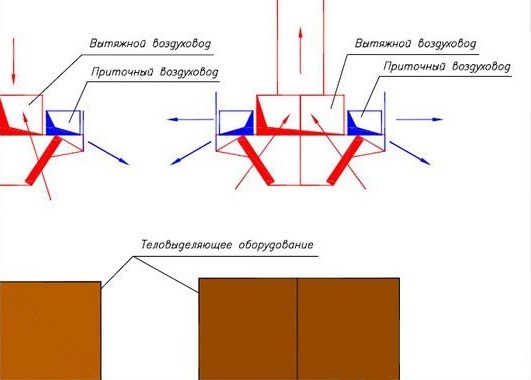
In restaurants, it is worth placing both supply and exhaust ventilation above each heat source, and if these the air ducts are at the top, the temperature contrast between the inside and the incoming air should not exceed 6 ° C
Modern buildings are equipped with autonomous air valveswhich remove stagnant air masses. Apartment owners can regulate them.
| Room type | Multiplicity | Room type | Multiplicity | Room type | Multiplicity | Room type | Multiplicity |
| Greenhouse | 25 — 50 | Laundry | 10 — 15 | Office | 6 — 8 | Hospital ward | 4 — 6 |
| Dyeing shop | 25 — 40 | Salon | 10 — 15 | Garage | 6 — 8 | Living room | 3 — 6 |
| Metalworking workshop | 20 — 40 | home kitchen | 10 — 15 | Gym | 6 — 8 | Entrance area, lobby | 3 — 5 |
| Bakery | 20 — 30 | Cafeteria | 10 — 12 | Workshop | 6 — 8 | Bedroom | 1,5 — 4 |
| Catering kitchen | 15 — 20 | Conference hall | 8 — 12 | Home toilet | 3 — 10 | Classroom | 2 — 3 |
| Changing room with shower | 15 — 20 | Basement | 8 — 12 | Attic | 3 — 10 | Pantry | 0,2 — 3 |
| Utility room | 15 — 20 | Shop | 8 — 10 | Meeting room | 4 — 8 | Switchboard room | 1 — 2 |
| Public toilet | 10 — 15 | Restaurant / bar | 6 — 10 | Bathroom / shower | 3 — 8 |
Additional ventilation devices solve issues with the maximum permissible concentrations of harmful substances. In residential buildings and public institutions, 0.1 mg / m³ for ozone and 0.005 mg / m³ for chlorine-containing compounds are considered acceptable values.
Residents will be even more secure if they make powerful mechanical ventilation.
Workshops and industrial premises
In industrial premises, conditions are more difficult and sometimes harmful. The air exchange rate in workshops should be several times higher than the parameters for other premises.
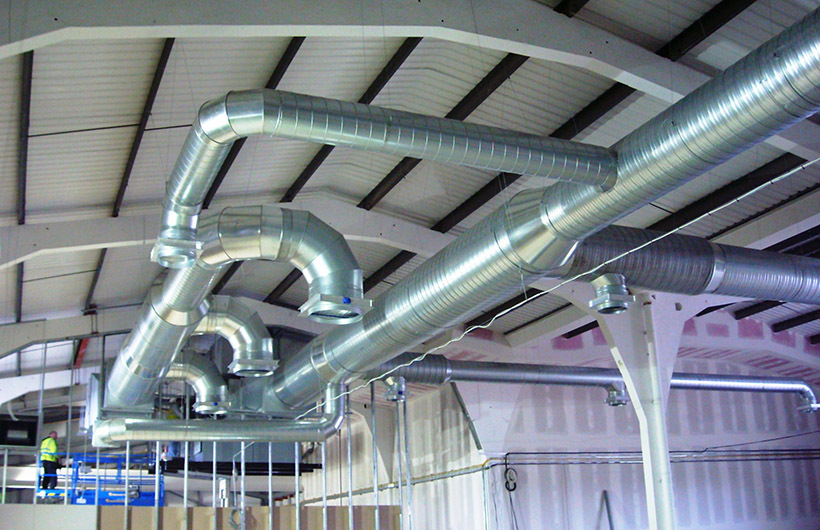
For industrial premises, a high-power air exchange with a large frequency is needed, and it is calculated by excess moisture, excess heat, explosive and harmful substances, emissions from personnel
Factors in the selection of the correct indicator for the ventilation of the workshop:
- Moisture percentage, excess moisture in the air. First of all, this applies to enterprises that use liquids in technological processes.
- Thermal energy generated by the equipment. Excessive heat from industrial machines must be removed through natural and mechanical ventilation.
- Pollution level and features of technological processes. There is a maximum permissible concentration for each chemical compound. Air exchange counts on the fact that the main harmful substances are present in the air in a minimum amount.
- Labor intensity. Strenuous physical activity and strenuous mental work will become easier and more doable with a high content of fresh air. In the case of manual labor, it is also about safety.
- The number of people working in the room at one time and throughout the day. Each employee should be provided with air based on the average requirement for 1 person.
The shape of the workshop and its volume are also important. The first parameter affects the movement of air masses, the second - the demand for air.
We'll have to take into account the stagnation of air and its swirl.
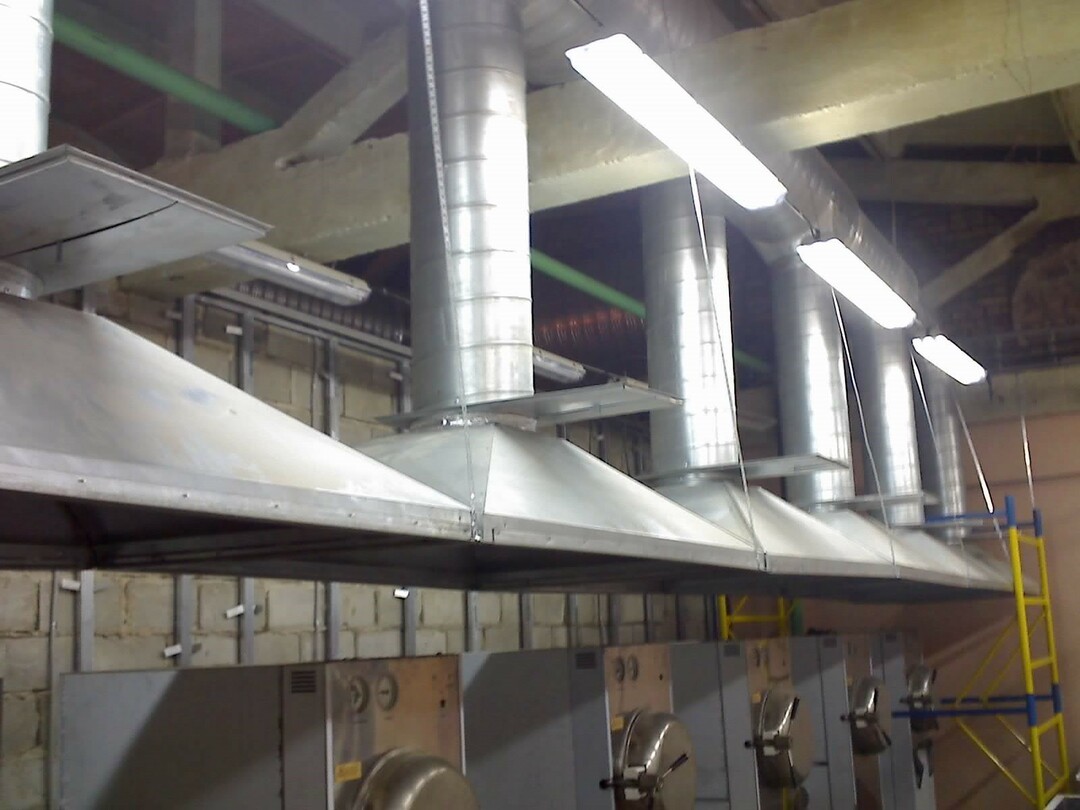
Workshops are painting, welding, mechanical assembly and mechanical: convective and radiant heat, smoke, compounds with inert gases and various impurities must be removed from these rooms.
For industrial facilities with hazardous and volatile chemicals. connections require 45 times exchange. Dyeing shops - 40. In rooms where workers use physical force to a large extent, the air must be refreshed 35 times per hour.
At production sites, where the work process does not include complex work and frequent use of physical effort - 30. In workshops where the work is light physical activity - 25.
The air exchange rate for industrial premises was indicated in SP 118.13330.2012, as well as in SP 60.13330.2012 and SP 60.13330.2016 - updated editions SNiP 41-01-2003.
Medical organizations and hospitals
In healthcare organizations, the life of patients and the speed of their recovery depends on air quality. Even more attention should be paid to this in children's hospitals. The multiplicity of air changeover for medical institutions regulates SP 158.13330.2014.
Most of all, rooms for infectious patients need air replacement. The required air exchange rate for them is 160 m³ / h per person. Wards for other patients (children and adults) need an air exchange rate of 80 m³ / h per person.
Indicators in m³ / h per person give more assurance that this rate of air exchange is sufficient to maintain and improve the health of the patients.
For doctors' offices and laboratory assistants there is enough 60 m³ / h for 1 person. The same amount of new air is required in rooms for needle and manual therapy, rooms for physiotherapy exercises, as well as in offices with permanent work places.
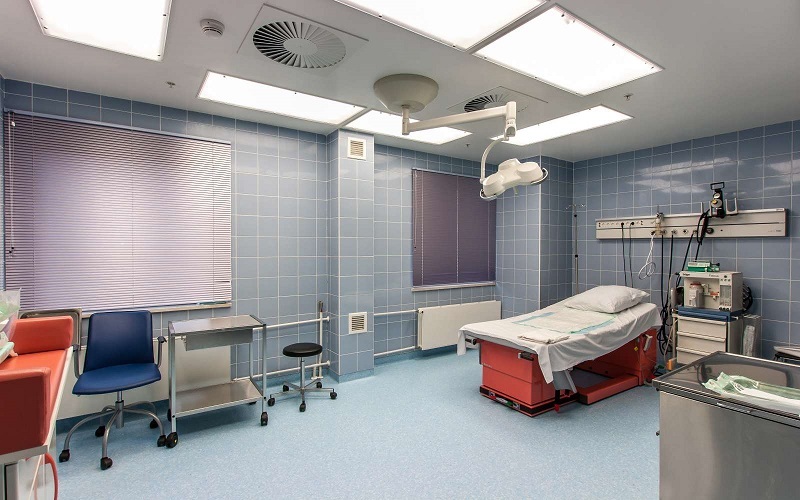
If the frequency of air substitution in the hospital is correct, then the ideal chemical and microbiological composition of the air will be provided with a minimum level of noise and vibration.
In many cases, it is possible to do without high-intensity air exchange, as well as without specific standards. In rooms for tomography and treatment rooms, 6-fold air changes are enough for receiving radiopharmaceuticals.
Five times per hour it is necessary to renew the air in the dirty areas of the DSO / CSO, rooms for sanitization patients, rooms for storing disinfectants, sorting used linen, processing and washing utensils.
In offices where drugs and sterile materials are stored, a 4-fold air change is needed. The same amount of new air is needed by the treatment rooms and rooms equipped for fluorographic and X-ray diagnostic examinations.
Air renewal three times is considered the norm for small medical equipment maintenance workshops, laboratory laboratory rooms, clean areas of the sterilization department.
The same standards apply to rooms for assay sorting, halls, functional and ultrasound diagnostics rooms.

In the intensive care unit, air exchange is designed to prevent the spread of combustion products, and fire dampers also help in this.
For buffets and eating areas in hospitals, a 2-fold air exchange is required. Just 1 air renewal per hour is enough for small offices where there is no permanent workplace.
The same amount is enough for small warehouses with equipment and clean materials, lobbies on the ground floor, archives, information offices, dressing rooms and storerooms.
Offices and business centers
Offices and government offices require more fresh air than individual housing. The reason for this is the large amount of office equipment, strenuous mental activity and customer service standards.
Ventilation criteria in offices:
- large size of ventilation ducts;
- the presence of mechanical and natural ventilation;
- efficient aeration with low power consumption;
- flexible control of the ventilation system: the ability to adjust and adjust for external weather conditions;
- convenient placement of mechanical and natural ventilation elements for carrying out repair and installation work of a different nature;
- the use of silent equipment or soundproofing;
- high-quality exhaust and forced ventilation;
- a constant supply of fresh air, ideally from the street.
The new air must effectively remove the vapors. It is worth paying attention to humidifying and purifying the air, cooling it or heating it before supplying it to the premises.
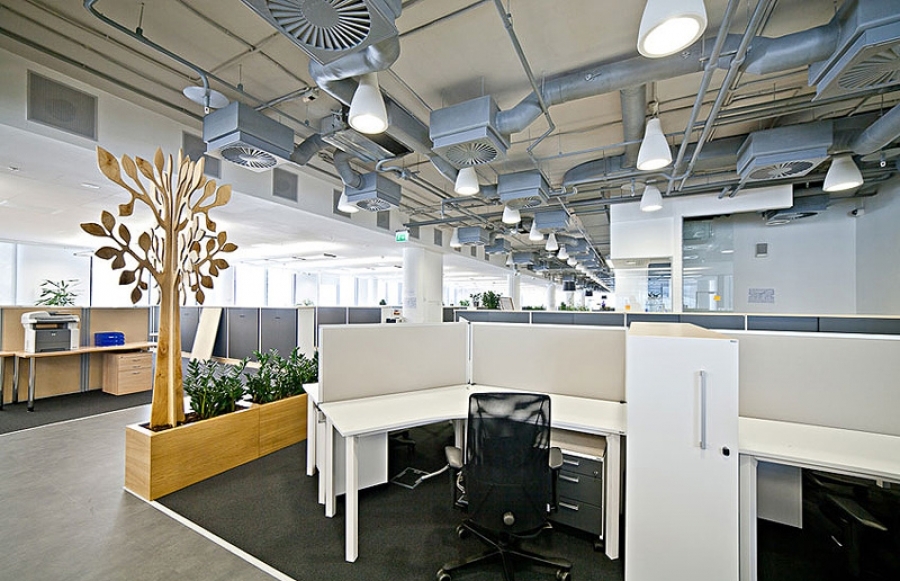
In large office rooms, a developed system of general exchange and local ventilation is made with valves, air distributors, air heaters, thermal insulation and automatic control
In a working room for 1 employee, at least 20 m³ / h is required. In conference rooms, the same is allocated for each visitor. Intensive air exchange should be provided in washrooms and sanitary rooms - up to 15 air renewals per hour.
Smoking areas will need 10x exchange. In the office of the manager / managers, an air exchange rate of 3 is required, in technical rooms - 1, in rooms with filing cabinets and storerooms - 0.5. The norms for offices are in the joint venture 118.13330.2012 and the international standard ASHRAE 62-1-2004.
Examples of calculating the frequency of air exchange
Take, for example, a 3.5 m high and 60 m² building that employs 15 people. We believe that the air is polluted only from the increase in the concentration of carbon dioxide due to respiration.
First we find room volume: V = 3.5 m × 60 m² = 210 m³.
We take into account that 1 average person emits 22.6 liters of carbon dioxide per hour.
We get that harmful discharge can be calculated by the formula B = 22.6 × n, where n corresponds to the number of people in the room.
B = 22.6 l / h × 15 = 339 l / h
For premises, the maximum permissible concentration of carbon dioxide is 1/1000, or 0.1%. Let's translate this into 1 l / m³. In clean air, carbon dioxide is about 0.035%. We translate into 0.35 l / m³.
Let's calculate how much fresh air is needed for all 15 people:
Q = 339 l / h: 1 l / m³ - 0.35 l / m³ = 339 l / h: 0.65 l / m³ = 521.5 m³ / h. Cubic meters in this case went into the numerator, and the hours - on the contrary, into the denominator.

In addition to calculating for harmful substances, the air exchange rate is important when regulating the amount of moisture and heat in the room: the corresponding formulas are shown in this image
We define air exchange rate:
N = 521.5 m³ / h: 210 m³ = 2.48 times per hour. It turns out that when the air changes at 2.48 times per hour, the concentration of carbon dioxide will remain within the normal range.
Let's find now specific ratio of air substitution for 1 person and 1 m². In this case, the volume of the room must be at least 210 m³, and the ceiling height - from 3.5 m.
521.5 m³ / h: 15 pers. = 34.7 m³ / h for 1 person
521.5 m³ / h: 60 m² = 8.7 m³ / h per 1 m² of area
Harmful discharge (B) is also calculated using the formula:
B = a × b × V × n, where:
a - coefficient of infiltration;
b - concentration of carbon dioxide, l / m³ for 1 hour;
V is the volume of the room, m³;
n is the number of people.
The content of substances can be measured in grams, not liters - it will be better for safety.
Conclusions and useful video on the topic
Frequency rate of air exchange for different premises of the store + drawing:
Application for calculating air exchange for different rooms:
Basic values for the ventilation system, air consumption:
The air exchange rate reflects the demand of the premises in the amount of air at which they function normally. Air changeability is expressed in the number of times per hour or cubic meters for the same period. There are also specific values for 1 person and 1 square meter.
Most of all, hospitals, hazardous industries and public places need fresh air. Life sometimes depends on the indicator of the minimum frequency of air exchange, so use not only the standards, but also count everything yourself and invite specialists.
Do you have questions about the rate of air exchange or related parameters? Ask them in the form below the article. You can also exchange valuable information with other readers. Perhaps your personal experience in this matter will be useful to someone.

